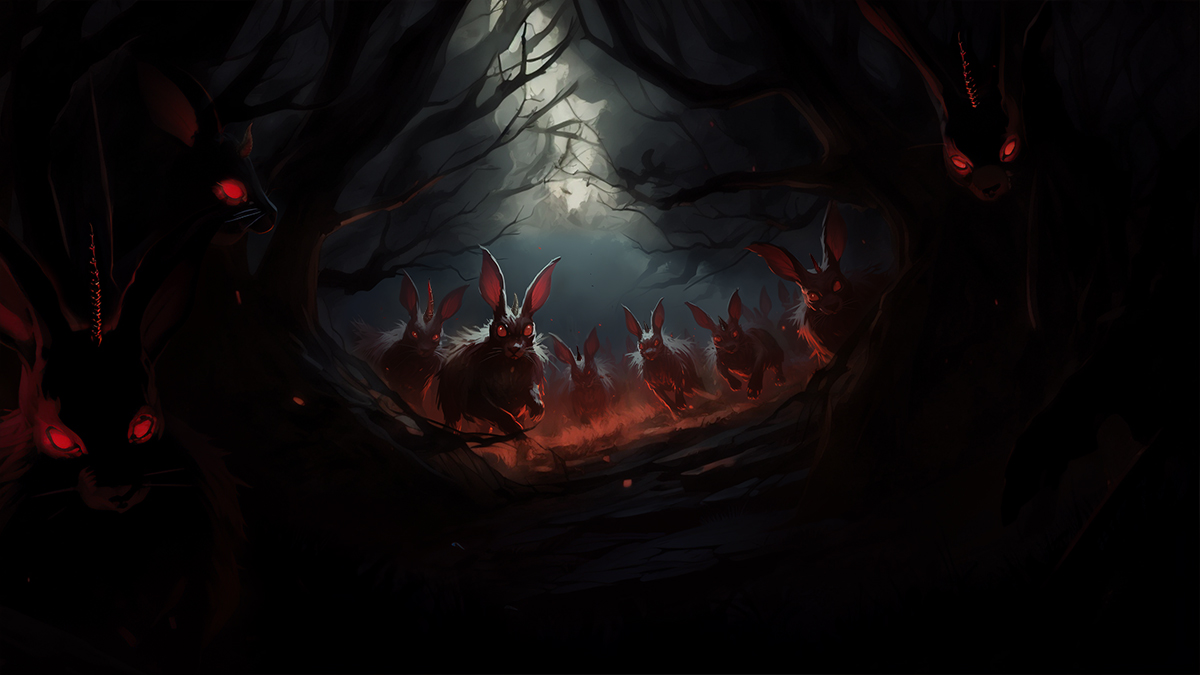The legend of the jackalope, a vicious creature said to be a cross between a jackrabbit and an antelope, is said to have originated in Persia.
In the USA, jackalopes have become associated with Wyoming, and in 2005, the state named it its Official Mythical Creature.
Description
Jackalopes are thought to be a cross between a jackrabbit and an antelope and are said to be extremely vicious. The first recorded stories were from Persia in the 13th century, but European stories of the creature later emerged in the 17th century.
The 17th-century European creatures even appeared in natural history texts.
The Persian tales present the small beast as a hare with a single horn projecting from its head. The 17th-century European creatures were known in Austria as raurackl and in Germany as wolpertinger. (The wolpertinger was also purported to have wings and be saber-toothed.)
There are even medieval Arabic texts which speak of a small horned animal living on an island. This creature has spanned the globe and featured in multiple cultures.
Experts have debunked these accounts. They say that there is a recognized condition in rabbits whereby a disease causes horn-like growths to appear (see Jackalope Sightings below). These growths are keratinous and very tough, therefore resembling horns and antlers.
These growths could occur anywhere on the rabbit’s body but sometimes appear on the head, leading to a possible explanation for the accounts of sightings.
Another possible explanation for these horned creatures is that they are an existing species of rabbit but with a birth defect. Some experts have also suggested these animals may have sustained some kind of injury.
Subsequent to the European sightings, the jackalope was popularized in America in the 1930s by a Wyoming man called Douglas Herrick. The first alleged sightings were made in Douglas, Wyoming, in 1829; Herrick revived the legend, and some still believe it today.
Herrick went as far as to start selling what he said were stuffed jackalopes. He told people that he and his brother had caught and killed them, risking life and limb to do so (jackalopes are supposed to attack people’s legs with their sharp horns).
According to Herrick, and legend, the jackalopes could imitate a human’s voice. There are tales from the Old West of jackalopes singing along with cowboys around campfires at night. It is said that jackalopes use this mimicry to help them evade capture when being hunted.
Apparently, the best way to catch a jackalope is to get it inebriated using its favorite drink – whiskey. Another odd attribute given to the jackalope in legend is that they only mate during a thunderstorm.
Douglas, Wyoming, is the self-styled American home of the jackalope. The town has a jackalope statue and celebrates Jackalope Day, usually in June. The Douglas Chamber of Commerce even grants jackalope hunting licenses, but these are only valid on July 31.
Sightings and Tales
Recently, a video was taken of a supposed jackalope in Bruce Peninsula National Park in Ontario, Canada. The video shows a rabbit with two extra projections behind its ears, but the reason for these is uncertain.
The video was taken near a nuclear power plant, but experts have dismissed the idea that the animal could be the result of some kind of genetic mutation caused by radiation.
The earliest recorded sighting by an American is that of John Colter, who was a part of the Lewis and Clark expedition. No one believed him at the time, but then they also didn’t believe his accounts of spouting geysers and bubbling mudpots.
While on a hunting trip in the 1930s, Dr. Richard Shope heard his friend talking about having seen rabbits with horns. Dr. Shope’s friend sent him a sample of these horns, which were subsequently examined under a microscope.
The horns turned out to be warts caused by papillomavirus, which causes cervical cancer in humans. As a direct result of this work, Dr. Shope, along with his researchers, set in motion years of research that would eventually culminate in the development and approval of the cervical cancer vaccine.
In the meantime, sightings of jackalopes continue around the world. In May 2022, a retired military man known as Rick reported a sighting in Turkey to Legends of America.
Rick claimed he came across the creature while driving on a treacherous mountain road. He saw the jackalope in the headlights and described it as looking like a rabbit but having antlers that would make a deer jealous. He said the creature ran like a dog.
| Other Name/s | Raurackl, Wolpertinger, Warrior Rabbit |
| Location | Canada, United States, Worldwide, |
| Type | Hybrid |
| Habitat | Countryside |
References
newanimal.org, “The Cryptid Zoo: Jackalope,” accessed August 18, 2017.
pome-mag.com, “Museum of Natural History – Small Wonder #1: The Jackalope”, accessed August 18, 2017.
mysteriousuniverse.org, “The Jackalope May Be Alive and Living in Canada,” accessed August 18, 2017.
thetruthhunter.com, “The Jackalope: Real, or Mythological Creature?” accessed August 18, 2017.
hoaxes.org, “The Jackalope,” accessed August 18, 2017.
sfgate.com, “Move over Elvis: History hopping with jackalope sightings,” accessed August 18, 2017.
https://www.cbc.ca/radio/thecurrent/the-current-for-march-29-2022-1.6400332/the-majestic-jackalope-and-how-it-became-a-folklore-legend-1.6400337, “The majestic jackalope and how it became a folklore legend,” accessed February 15, 2023.
https://utahstories.com/2022/06/a-jackalope-sighting-in-utah-horned-rabbits-are-the-mascots-of-the-american-west-but-are-they-real/, “A Jackalope Sighting in Utah? Horned Rabbits are the Mascots of the American West, but are they Real?” accessed February 15, 2023.
https://zooatlanta.org/are-jackalopes-real/, “ARE JACKALOPES REAL?” accessed February 15, 2023.
https://www.ncbi.nlm.nih.gov/pmc/articles/PMC2132321/, “INFECTIOUS PAPILLOMATOSIS OF RABBITS,” accessed February 16, 2023.
https://www.legendsofamerica.com/wy-jackalope/, “Jackalopes of Wyoming – Myth or Reality?” accessed February 16, 2023.

[…] out the Jackalope page for more […]